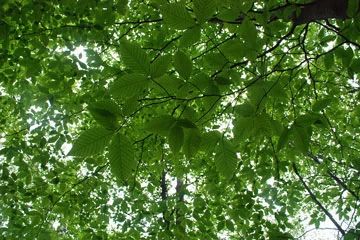Peninsula Park Beech Forest
No. 12

Photo by Josh Mayer
Peninsula Park Beech Forest features a continuum of forest types from the dry edge of the Niagara dolomite escarpment to rolling uplands forested with mesic species. The northern mesic forest is old second-growth, with sugar maple, American beech, hemlock, yellow birch, white birch, and ironwood; some trees are nearly 2 feet in diameter. Understory species include yellow blue-bead-lily, large-flowered trillium, red baneberry, Hooker's orchid, and bracted orchid. Relict red oak and white pine are scattered through the area.
To the east, between Shore Road and the bluff edge, is a young northern dry-mesic forest dominated by red oak and white pine. The bluff drops 150 feet to several terraces, which are forested with white cedar and hardwoods. The base of the bluff along Green Bay supports many ferns including bulblet, fragile, polypody, slender cliff brake, walking, and marginal wood ferns. The beach is composed of dolomite cobblestones with little vegetation. Numerous mesic forest plants and animals are present along with several uncommon orchids. Noted University of Wisconsin plant ecologist John Curtis used this site as a representative northern mesic forest study site. Peninsula Park Beech Forest is owned by the DNR and was designated a State Natural Area in 1952.
Very few State Natural Areas have public facilities, but nearly all are open for various recreational activities as indicated below. Generally, there are no picnic areas, restrooms, or other developments. Parking lots or designated parking areas are noted on individual SNA pages and maps. If a developed trail is present, it will normally be noted on the SNA map and/or under the Maps tab. A compass and topographic map or a GPS unit are useful tools for exploring larger, isolated SNAs.
The good majority of SNAs are isolated and have few or no facilities. Some SNAs have vehicle access lanes or parking lots, but their accessibility may vary depending on weather conditions. Parking lots and lanes are not plowed during winter. Hiking trails may be nonexistent or consist of undeveloped footpaths. A GPS unit or compass and a detailed topographic map are useful tools for exploring larger SNAs.
Entrance fees: Except for Parfrey's Glen, the Cambrian Outlook in the Dells of the Wisconsin River, SNAs within State Parks and some within State Forests, all other DNR-owned SNAs do not have any admission fees. For more information, see Wis. Admin. Code NR 45 [exit DNR]. For non-DNR-owned SNAs, we are unaware of any vehicle or admission fees. However, please contact the landowner for more information.
Allowable activities: DNR-owned land
The activities listed below are generally allowed on all DNR-owned SNA lands. Exceptions to this list of public uses, such as SNAs closed to hunting, are noted above and posted with signs on the property site.
- Hiking
- Fishing
- Cross country skiing
- Hunting
- Trapping
- Scientific research (permit required [PDF])
- Outdoor education
- Wild edibles (What is this?)
- Pets (Rules)
- Wildlife viewing
Prohibited activities: all SNAs
Although a handful of sites allow activities like primitive camping (e.g. Lower Chippewa River on sand bars) or horseback riding (e.g. S. Kettle Moraine), the activities listed below are generally prohibited on DNR-owned SNAs.
- Camping and campfires
- Collecting of animals (other than legally harvested species), non-edible fungi, rocks, minerals, fossils, archaeological artifacts, soil, downed wood, or any other natural material, alive or dead.
- Collecting for scientific research requires a permit issued by the DNR
- Collecting of plants including seeds, roots or other non-edible parts of herbaceous plants such as wildflowers or grasses
- Drones: Flying-related activities, including the use of drones, hang-gliders and model airplanes, are prohibited. Permission may be issued by the SNA Program for the use of drones for educational or research purposes
- Geocaching
- Horseback riding
- Rock climbing
- Vehicles, including bicycles, ATVs, aircraft, and snowmobiles except on trails and roadways designated for their use.
For rules governing state-owned SNAs and other state lands, please consult Chapter NR 45 Wis. Admin. Code [exit DNR].
Location
Within Peninsula State Park, Door County. T31N-R27E, Sections 14, 15, 22. 83 acres.
Driving directions
From Ephraim, go south on State Highway 42 about 1 mile to the north entrance to Peninsula State Park. Follow Shore Road north to the Eagle Tower parking area. Access to the natural area is via Shore Road, Highland Road, or the Sentinel Hiking Trail, which forms the northern boundary of the site. A Wisconsin State Park sticker must be displayed on all vehicles entering the park.
The DNR's state natural areas program is comprised of lands owned by the state, private conservation organizations, municipalities, other governmental agencies, educational institutions and private individuals. While the majority of SNAs are open to the public, access may vary according to individual ownership policies. Public use restrictions may apply due to public safety, or to protect endangered or threatened species or unique natural features. Lands may be temporarily closed due to specific management activities.
Users are encouraged to contact the landowner for more specific details. The data shown on these maps have been obtained from various sources, and are of varying age, reliability, and resolution. The data may contain errors or omissions and should not be interpreted as a legal representation of legal ownership boundaries. To create your custom map where you can zoom to a specific location, please use the DNR's Mapping Application.
Peninsula Park Beech Forest is owned by: Wisconsin DNR
